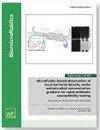用于核酸检测的数字微流控方法:微型综述
IF 2.4
4区 工程技术
Q2 BIOCHEMICAL RESEARCH METHODS
引用次数: 0
摘要
人类历史上曾发生过许多严重的传染病。通过核酸检测快速准确地检测和隔离感染者,是遏制这些病毒传播的有效手段。然而,传统的核酸检测方法依赖于复杂的机器和专业人员,难以实现大规模、高通量和快速检测。近年来,数字微流控技术异军突起,它整合了电动力学、声学、光学、磁学和力学等多个领域,是一项前景广阔的技术。利用这些不同技术的优势,数字微流控芯片具有多种优点,如检测通量高、集成多种功能、试剂消耗低和便携性强。这种快速高效的检测对于及时检测和隔离感染者以防止病毒传播至关重要。数字微流控芯片的另一个优势是试剂消耗低。与传统方法相比,这些芯片所需的试剂量更少,从而节省了成本,减少了浪费。此外,数字微流控芯片便于携带,可轻松集成到护理点检测设备中。这样就能在偏远或资源有限的地区进行检测,而这些地区可能难以获得复杂的实验室设备。现场检测减少了与样本运输相关的时间和成本。总之,基于数字微流控原理的生物测定技术有可能大大改善传染病的检测和控制。通过实现快速、高通量和便携式检测,这些技术可提高我们遏制传染病传播和有效管理公共卫生疫情的能力。本文章由计算机程序翻译,如有差异,请以英文原文为准。
Digital microfluidics methods for nucleic acid detection: A mini review
Many serious infectious diseases have occurred throughout human history. Rapid and accurate detection as well as the isolation of infected individuals, through nucleic acid testing, are effective means of containing the spread of these viruses. However, traditional nucleic acid testing methods rely on complex machines and specialized personnel, making it difficult to achieve large-scale, high-throughput, and rapid detection. In recent years, digital microfluidics has emerged as a promising technology that integrates various fields, including electrokinetics, acoustics, optics, magnetism, and mechanics. By leveraging the advantages of these different technologies, digital microfluidic chips offer several benefits, such as high detection throughput, integration of multiple functions, low reagent consumption, and portability. This rapid and efficient testing is crucial in the timely detection and isolation of infected individuals to prevent the virus spread. Another advantage is the low reagent consumption of digital microfluidic chips. Compared to traditional methods, these chips require smaller volumes of reagents, resulting in cost savings and reduced waste. Furthermore, digital microfluidic chips are portable and can be easily integrated into point-of-care testing devices. This enables testing to be conducted in remote or resource-limited areas, where access to complex laboratory equipment may be limited. Onsite testing reduces the time and cost associated with sample transportation. In conclusion, bioassay technologies based on digital microfluidic principles have the potential to significantly improve infectious disease detection and control. By enabling rapid, high-throughput, and portable testing, these technologies enhance our ability to contain the spread of infectious diseases and effectively manage public health outbreaks.
求助全文
通过发布文献求助,成功后即可免费获取论文全文。
去求助
来源期刊

Biomicrofluidics
生物-纳米科技
CiteScore
5.80
自引率
3.10%
发文量
68
审稿时长
1.3 months
期刊介绍:
Biomicrofluidics (BMF) is an online-only journal published by AIP Publishing to rapidly disseminate research in fundamental physicochemical mechanisms associated with microfluidic and nanofluidic phenomena. BMF also publishes research in unique microfluidic and nanofluidic techniques for diagnostic, medical, biological, pharmaceutical, environmental, and chemical applications.
BMF offers quick publication, multimedia capability, and worldwide circulation among academic, national, and industrial laboratories. With a primary focus on high-quality original research articles, BMF also organizes special sections that help explain and define specific challenges unique to the interdisciplinary field of biomicrofluidics.
Microfluidic and nanofluidic actuation (electrokinetics, acoustofluidics, optofluidics, capillary)
Liquid Biopsy (microRNA profiling, circulating tumor cell isolation, exosome isolation, circulating tumor DNA quantification)
Cell sorting, manipulation, and transfection (di/electrophoresis, magnetic beads, optical traps, electroporation)
Molecular Separation and Concentration (isotachophoresis, concentration polarization, di/electrophoresis, magnetic beads, nanoparticles)
Cell culture and analysis(single cell assays, stimuli response, stem cell transfection)
Genomic and proteomic analysis (rapid gene sequencing, DNA/protein/carbohydrate arrays)
Biosensors (immuno-assay, nucleic acid fluorescent assay, colorimetric assay, enzyme amplification, plasmonic and Raman nano-reporter, molecular beacon, FRET, aptamer, nanopore, optical fibers)
Biophysical transport and characterization (DNA, single protein, ion channel and membrane dynamics, cell motility and communication mechanisms, electrophysiology, patch clamping). Etc...
 求助内容:
求助内容: 应助结果提醒方式:
应助结果提醒方式:


